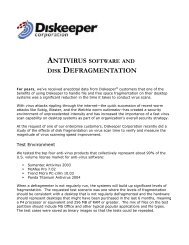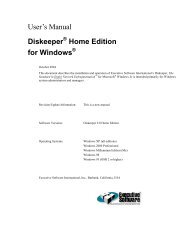Diskeeper 10 User's Manual
Diskeeper 10 User's Manual
Diskeeper 10 User's Manual
You also want an ePaper? Increase the reach of your titles
YUMPU automatically turns print PDFs into web optimized ePapers that Google loves.
88 Glossary<br />
PATA: Parallel Advanced Technology Attachment. Originally called ATA, but retroactively renamed PATA<br />
with the introduction of Serial Advanced Technology Attachment (SATA) interfaces. One of several methods<br />
of interfacing disk drives and other devices to computers. See also ATA, IDE, SATA and SCSI.<br />
Pentium: The name of a type of processor, introduced by Intel in 1993. It is the successor to the 80486 and<br />
equivalent to the 80586 chip in the x86 series.<br />
peripheral device: (Related to periphery, roughly meaning “on the outside.”) A device, such as a disk drive,<br />
printer, keyboard or mouse, connected to and used by a computer.<br />
permission: The ability of a user on a computer system to access or modify files, especially those that he or she<br />
did not create. Permissions exist for security reasons, to prevent unauthorized access to sensitive information.<br />
The system administrator assigns permissions, or “who has access to what.”<br />
platform: The environment, in which a computer system operates, either based on the computer’s CPU or its<br />
operating system. For example: the x86 platform, or the Windows Server 2003 platform.<br />
platter: A disk drive consists of one or more platters, each of which can receive magnetic recordings on both<br />
sides. The platter spins like a phonograph record on a turntable.<br />
primary partition: In Windows and MS-DOS operating systems, the disk space on a disk drive may be divided<br />
into a maximum of four primary partitions; or three primary partitions plus an extended partition, which in turn<br />
can contain one or more logical drives.<br />
priority: On a Windows system, several programs can appear to be running at once, even though the CPU can<br />
only process one instruction at a time. With the help of the operating system, the CPU processes a few<br />
instructions from one program, then a few instructions of the next program, and so on, over and over. Without<br />
priority assignments, each program would be given about the same amount of time in each “time slot.” but by<br />
assigning priorities, the more important programs can be given longer time intervals than the less important<br />
ones, allowing them to complete faster.<br />
process: A program, along with the system resources the program requires to run. A process represents a unit<br />
of resource ownership and work to be done. The operating system creates processes to keep track of resources<br />
and to ensure the proper scheduling of tasks.<br />
processor: See central processing unit.<br />
program: A set of instructions that tell a computer what to do. Synonym: software.<br />
RAID: Redundant Array of Independent Disks. A method of combining several disk drives to make one large<br />
volume. Typically used on a network file server to achieve faster access, greater protection against disk failure,<br />
or both.<br />
record: A collection of related data items, treated as a unit. For example, in a file containing information about<br />
a company’s customers, one record would consist of the particulars (name, address, phone number, etc.) of one<br />
customer. See also field.<br />
registry: A database that contains information about current hardware settings, installed software, user<br />
preferences and associations between file types, and applications that access those files.<br />
resource: Any part of a computer system, such as a disk drive, printer, or memory, which can be used by a<br />
program.<br />
scandisk: A program (supplied with Windows 95, Windows 98 and Windows Me) that checks the integrity of<br />
a disk and corrects disk errors such as lost clusters. See also CHKDSK.<br />
SCSI: Small Computer System Interface. One of several methods of interfacing disk drives and other devices to<br />
computers. See also ATA, IDE, PATA, and SATAI.<br />
SATA: Serial Advanced Technology Attachment. A successor to ATA (which was later renamed PATA). One<br />
of several methods of interfacing disk drives and other devices to computers. See also ATA, IDE, PATA and<br />
SCSI.






